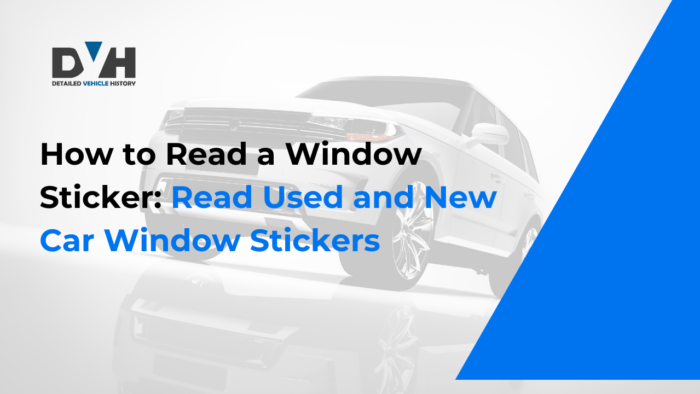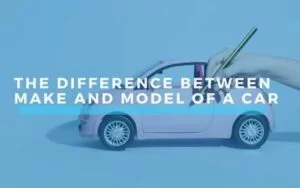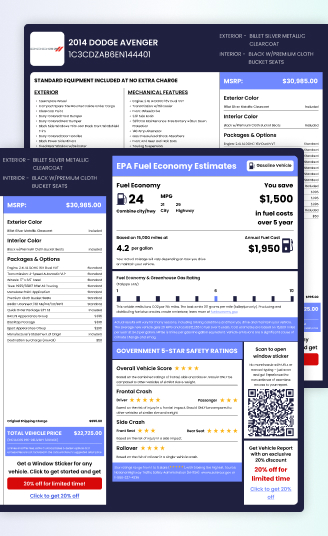If you’ve ever stood in front of a car’s showroom window or in the inventory of a used car dealership and wondered about the mysterious information on that sticker, you’re not alone. That small piece of paper found on every car, known as a car window sticker, holds the key to understanding what a vehicle has to offer. In this guide, we’ll provide you with a complete breakdown of how to read window stickers, empowering you to decode its details and make informed decisions when considering your next car purchase.
What Is a Window Sticker?
Before we jump into business and learn how to read a window sticker, let’s start with the basics. What is a used or new car window sticker? A window sticker, also known as a Monroney sticker, is a label affixed to the window of a new vehicle. It’s required by law in the United States and contains crucial information about the vehicle’s specifications, features, packages, pricing, and more. Essentially, it’s your guide to what’s under the hood and inside the cabin.
Now, let’s break down the process of reading a window sticker step by step so you can confidently navigate and understand the bulk of information it contains and effectively know how to read a window sticker.
How to Read a Window Sticker: Information Found After a Window Sticker Lookup
Reading a window sticker becomes extremely important if you’re a car shopper out there in search of the perfect used car to buy. With an automobile window sticker, you can gain full access to vehicle information and be certain about the vehicle’s specs and others. How can you read a window sticker? The information found on a window sticker by VIN includes:
Vehicle Description
The first section you’ll find on a window sticker is the vehicle description. It provides essential details about the car and its automaker, including its make, model, trim level, and engine type. You’ll first encounter the make and model, which represent the brand or manufacturer (e.g., Ford) and the specific product line (e.g., Mustang). Next, the trim level reveals the car’s flavor, with various levels offering different features and options (e.g., LX, EX, or Touring).
Engine type, if mentioned, tells you about the car’s power source (e.g., 4-cylinder or hybrid), and drivetrain indicates how power is distributed to the wheels (e.g., front-wheel drive or all-wheel drive). Knowing this information ensures you’re looking at the right vehicle for your needs.
Standard Equipment
As you move down the window sticker, you’ll come across a list of standard and optional equipment. This is where you can see what features come included with the base model and what upgrades or packages are available. Standard equipment includes the features and amenities included in the vehicle’s base model. These are the essentials that you can expect to find without any additional costs. They often include items like model information, interior and exterior features, technical and mechanical features, powertrain, and safety features.
Optional Equipment
On the other hand, optional equipment allows you to tailor the vehicle to your preferences and needs. It includes a wide array of features and packages that can enhance your driving experience. Whether you’re looking for advanced infotainment systems, premium sound options, or safety enhancements like advanced driver-assistance systems, the window sticker’s optional equipment section provides you with choices to customize your vehicle.
By carefully reviewing the standard and optional equipment, you can ensure that your new car meets your expectations and suits your lifestyle.
Manufacturer’s Suggested Retail Price (MSRP)
This section on an original window sticker by VIN is where you get a clear breakdown of the costs associated with your vehicle. It’s crucial to understand the overall investment you’re making and what’s included in the car. At the forefront is the Manufacturer’s Suggested Retail Price (MSRP), representing the starting point before any additional features or taxes. This sticker price, base price, gives you a baseline for the vehicle’s cost.
However, the pricing section doesn’t stop there. There are also a bunch of other fees displayed on the window sticker, including the destination charge.
Total Price, Shipping, and Destination Charge
In addition to the MSRP, the window sticker, also referred to as a Monroney label, also reveals other charges, like the destination fee. This fee covers the cost of bringing your vehicle from the factory to the dealership so it’s ready for you. So, keep an eye on this section to understand your vehicle’s total price. You may also find more costs; it may detail any additional options or packages you’ve chosen, each with its respective cost. Taxes, if not included here, are typically added by the dealers and vary by location. So, keep an eye out for this section.
EPA Fuel Economy and Environment
Next on the window sticker is the fuel economy and environment section. This section, found on the top right corner of the window sticker, provides crucial insights into a vehicle’s environmental performance and efficiency, helping you make eco-conscious choices and manage your fuel expenses effectively in line with the Environmental Protection Agency guidelines.
Central to this section are the fuel economy ratings, which include both city and highway MPG (miles per gallon). These ratings offer an estimate of how many miles your vehicle can travel per gallon of fuel in different driving conditions. This information allows you to gauge your future fuel costs and make environmentally conscious decisions based on your daily driving patterns.
Annual Fuel Costs
This section of the window sticker provides an estimate of the annual fuel costs associated with your vehicle. It’s a valuable piece of information for budget-conscious buyers, as it helps you understand how much you might spend on fuel in a typical year of driving.
The calculation takes into account factors like the vehicle’s fuel efficiency, the average cost of fuel in your area, and the estimated number of miles you’ll drive annually. By providing an approximation of your yearly fuel expenses, this section allows you to factor fuel costs into your overall budget and make more informed decisions about your vehicle purchase.
Greenhouse Gas Ratings
In addition to the estimated fuel economy, the window sticker provided by Detailed Vehicle History also details the vehicle’s emissions information. The Greenhouse Gas Rating informs you about the car’s impact on the environment, particularly in terms of greenhouse gas emissions. Here you can also find a Smog rating and you can determine the amount of CO2 emitted per mile. Getting an automobile window sticker lookup provides an opportunity for you to purchase a vehicle with lower emissions that contribute less to air pollution and are generally more environmentally friendly. Save the earth with a window sticker today!
Safety Ratings
This section highlights safety ratings provided by organizations like the National Highway Traffic Safety Administration (NHTSA) or the Insurance Institute for Highway Safety (IIHS). These ratings reflect the vehicle’s performance in crash tests and offer valuable insights into its safety performance. NHTSA’s ratings usually range from 1 to 5 stars with 5 stars being the highest rating.
QR Codes and Barcodes
Detailed Vehicle History provides modern window stickers featuring QR codes and barcodes. Scanning these codes with your smartphone can provide you with instant access to additional information about the vehicle, including its history, specifications, and even reviews. It’s a convenient way to take a deep look into a vehicle’s details. Get an original car sticker lookup with our tool today.
Warranty Information
You will find details about the warranty of any car including basic coverage, powertrain, road-assistance warranty and more in the window sticker. The window sticker shows the warranty in terms of months and mileage traveled by any car.
So, there you have it! Learning how to read an automotive sticker is an essential skill when shopping for a vehicle. It enables you to gain access to as much information as possible before committing to any purchase. From the vehicle description to pricing, safety features, and more, the window sticker is your guide to understanding what a car has to offer. So, next time you’re in front of that showroom window or at that used car dealership, you’ll have the knowledge to read and understand the details on that small piece of paper.
EPA Section on Electric Vehicles: A Comprehensive Look with Tesla
This section of the window sticker, often found on Tesla’s electric vehicles, offers vital insights into energy efficiency, environmental impact, and cost savings. Here are some of the most important details you can find on a Tesla EPA label on a window sticker:
- MPGe (Miles Per Gallon of Gasoline Equivalent): Tesla’s EPA label prominently showcases MPGe ratings for both city and highway driving. For instance, a Tesla Model 3 may display an MPGe of 150 in the city and 133 on the highway. MPGe serves as a standardized measure of energy efficiency, indicating how far the vehicle can travel on the energy equivalent of one gallon of gasoline.
- Estimated Annual Energy Cost: Tesla’s EPA label provides an estimate of the annual energy cost for powering the vehicle. This estimate is based on the vehicle’s energy efficiency and the local cost of electricity. For instance, it might indicate an annual electricity cost of $550.
- Total Driving Range: Tesla electric vehicles are renowned for their impressive driving ranges. The EPA section includes an estimate of the total driving range on a full battery charge. A Tesla Model S, for example, may indicate a range of 370 miles. This figure is essential for prospective buyers planning both daily commutes and longer trips.
- Greenhouse Gas Emissions: Tesla’s electric vehicles have a significant environmental advantage, as they produce zero tailpipe emissions. The EPA sticker typically highlights this by stating “0” for both city and highway emissions, emphasizing the environmental benefits of electric vehicles.
- Charge Time: Tesla’s EPA label includes information on the estimated time required to charge the vehicle’s battery fully using various charging methods, such as Level 1, Level 2, or fast charging. This data assists consumers in understanding the practical aspects of recharging an electric vehicle.
Fuel Cost Savings for Five Years: Tesla’s EPA section may estimate the fuel cost savings over a five-year period compared to an average new vehicle. This calculation takes into account the vehicle’s energy efficiency and local electricity rates, providing consumers with insights into long-term cost benefits.
Need an Original Car Window Sticker?
Are you buying a used car and need some information for the vehicle? If you are, then you are on the right track! Get detailed access instantly by following these steps:
- Navigate to the window sticker lookup tool
- Fill out the provided form with the required information; Vehicle Identification Number (VIN), phone number, and email address.
- Proceed to payment and access your dashboard / account.
- View the detailed window sticker instantly.
Make the right decision with the help of a detailed window sticker today! Get access to all these details and more instantly. If you need accurate warranty information for used and new vehicles, our VIN lookup tool is your best bet. With concise car reports, buyers can make sure they’re buying reliable vehicles with clean titles and records.










